The hare-raising antics of the brown hare
Seeing a hare is a very special sight, and one of the star attractions at WWT Welney. They are full of personality and not a little bit fiery! Learn more about their fascinating behaviour and lives.
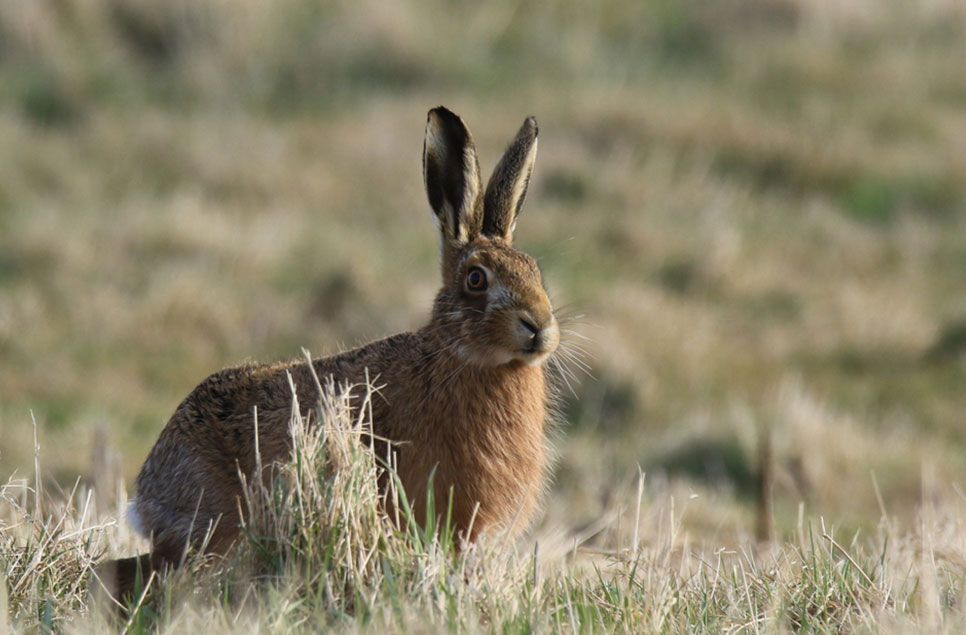
Boxing hares put on one of the most entertaining and dramatic displays you can see in spring. Wetlands are a great place to watch for hares, the wide open spaces providing a fantastic arena in which to see the action. The courtship ritual involves less romance and more frantic chases, animals leaping over each other, kicking and biting, and of course, brief boxing matches.
While there are some skirmishes between competing males (jacks), most boxing bouts are actually females (jills) rebuffing the advances of overeager, or even desperate males. This behaviour, although not much fun for the females, means that only the strongest and most tenacious jacks get the pick of the jills.
European brown hares are quite solitary by nature, and don’t get much enjoyment in the company of their species. After the frenzy of courtship, hares disperse to their more usual ways. This is where the phrase ‘mad as a march hare’ comes from - it’s so different from their usual behaviour.
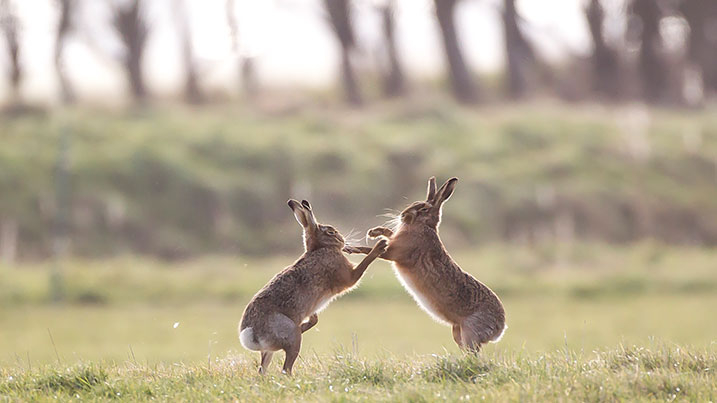
How to tell the difference between a rabbit and a hare
Hares, like rabbits, are lagomorphs. They are not rodents because they have an extra pair of small teeth behind the large incisors. Like rabbits, they use a special digestive trick of “refection”, or eating their own droppings (not as disgusting as it sounds). Because cellulose is so difficult to digest, after it’s been through the gut once, rabbits and hares eat it again.
- Hares are much larger than rabbits, twice the body weight, and surprisingly tall if you can get close enough to stand next to it.
- Unlike rabbits, young hares or leverets are born fully furred with open eyes above ground, and pretty much ready to go.
- Also unlike rabbits, hares live an independent existence and rely on speed to escape from danger. They can attain 45mph at full throttle, changing direction remarkably quickly and frequently.
- Hares do not make burrows. They are more active at night, and spend much of the day lying in their forms, which are shallow depressions in the grass.
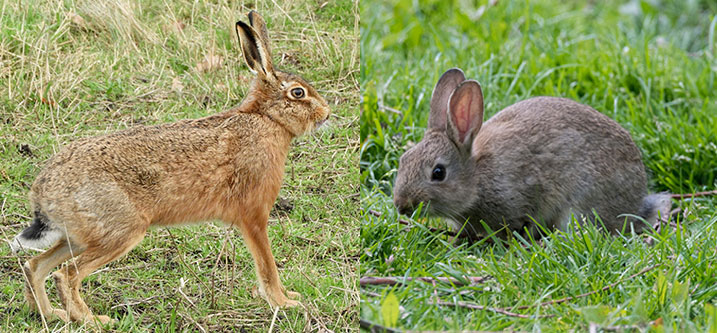
Brown hare or mountain hare?
If you’re in Scotland, Ireland or the very north of England, you might find yourself in a habitat populated by both the brown hare and the mountain hare. Only the mountain hare is native to the UK, with the brown hare being introduced by man much like the rabbit was. If you’re unsure, here are some key differences to help tell them apart:
- Brown hares are generally larger, with longer black-tipped ears
- A brown hare’s eyes are a lighter amber brown, the mountain hare’s are darker
- The brown hare’s tail has a black top, the other has a pure white one
- Most tellingly, the mountain hair has a dull grey-brown coat that turns white in winter
How hares rear their young
Hares are capable of producing four litters of leverets in a good year. But later matings do not involve the frenzy of spring, and happen more by chance or devious strategy.
Newly born leverets are vulnerable to predators. So within a few days of birth, the mother hare moves her leverets to other individual forms, carrying them by the scruff of the neck, to increase security. A jill nursing her young will visit each of her leverets in turn to feed and clean them. This visit is every 24 hours, shortly after dusk. There are many rural stories of the ferocity of a jill defending her young, including fighting off foxes, and killing stoats with their powerful hind legs, which have sharp claws.
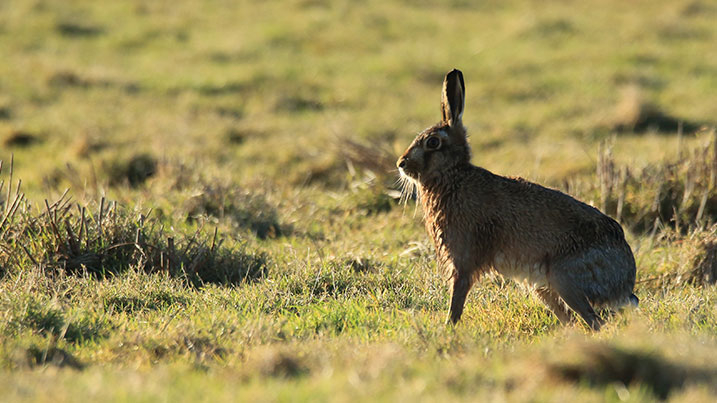
Hare diet and habitat
Hares are not wetland specialists, but can be seen at many of our wetland reserves. They prefer the habitat of open farmland, fenland or grassland, such as found at WWT Welney or Caerlaverock, and one was recently spotted at Slimbridge. In winter, brown hares will seek the shelter of woodland and small copses, supplementing their diet of grasses, herbs and buds with woody material.
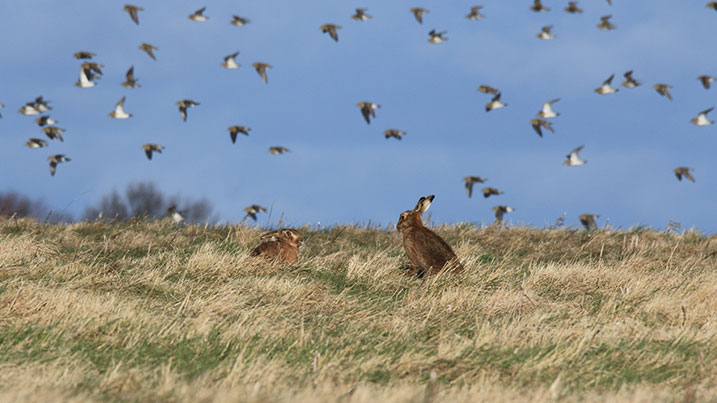
Hare conservation status
All species of hare in Britain are declining. They are listed as priority species in the UK Biodiversity Action Plan. UK BAP priority species are those that were identified as being the most threatened and requiring conservation action. Changes in agricultural practices are probably responsible for the decline in the brown hare population of Britain, and in particular the switch to silage and the heavy use of weed killers. Silage is cut when leverets are still very young, and the machines get faster and faster. Also, hares are vulnerable to disease, and coccidiosis is a highly contagious infection.
Experience wetland wildlife
At WWT Wetland Centres you’ll find stunning nature reserves full of wildlife. We’re only opening with restrictions at the moment due to coronavirus, so please check the centre page and make a booking before travelling.
Find your nearest wetland centreHare facts and fiction
- In folklore, hares have been associated with witchcraft, and were a popular animal to be suspected as a ‘familiar’ or witch’s sidekick. Witches were also considered to be able to turn themselves into hares.
- There’s no one strong theme the hare is connected with, but they have particularly come to symbolise moon deities, fertility and sensuality. Their sudden movements and apparent disappearances has also led to them being portrayed as fast, tricksy characters in both North African mythology and North American: the famous trickster Brer Rabbit was in fact a hare.
- Many observers have noted that hares appear to enjoy loud noises. They gather in groups and “party” during thunderstorms. They also appear to enjoy being near to jet aircraft on runways. No one knows why!
- A group of hares is called a drove. However due to their somewhat solitary nature, you’re only likely to see this in breeding season.
- Hares are very nervous creatures, and never return to their form in a straight line. They will even double back on themselves and leap great sideways distances to break scent trails.
We urgently need to ask for your help to save our wildlife.
As our world strives to come to terms with COVID-19 many of the vulnerable wetland species you’ve just been reading about are at greater risk than ever before.
DONATE


